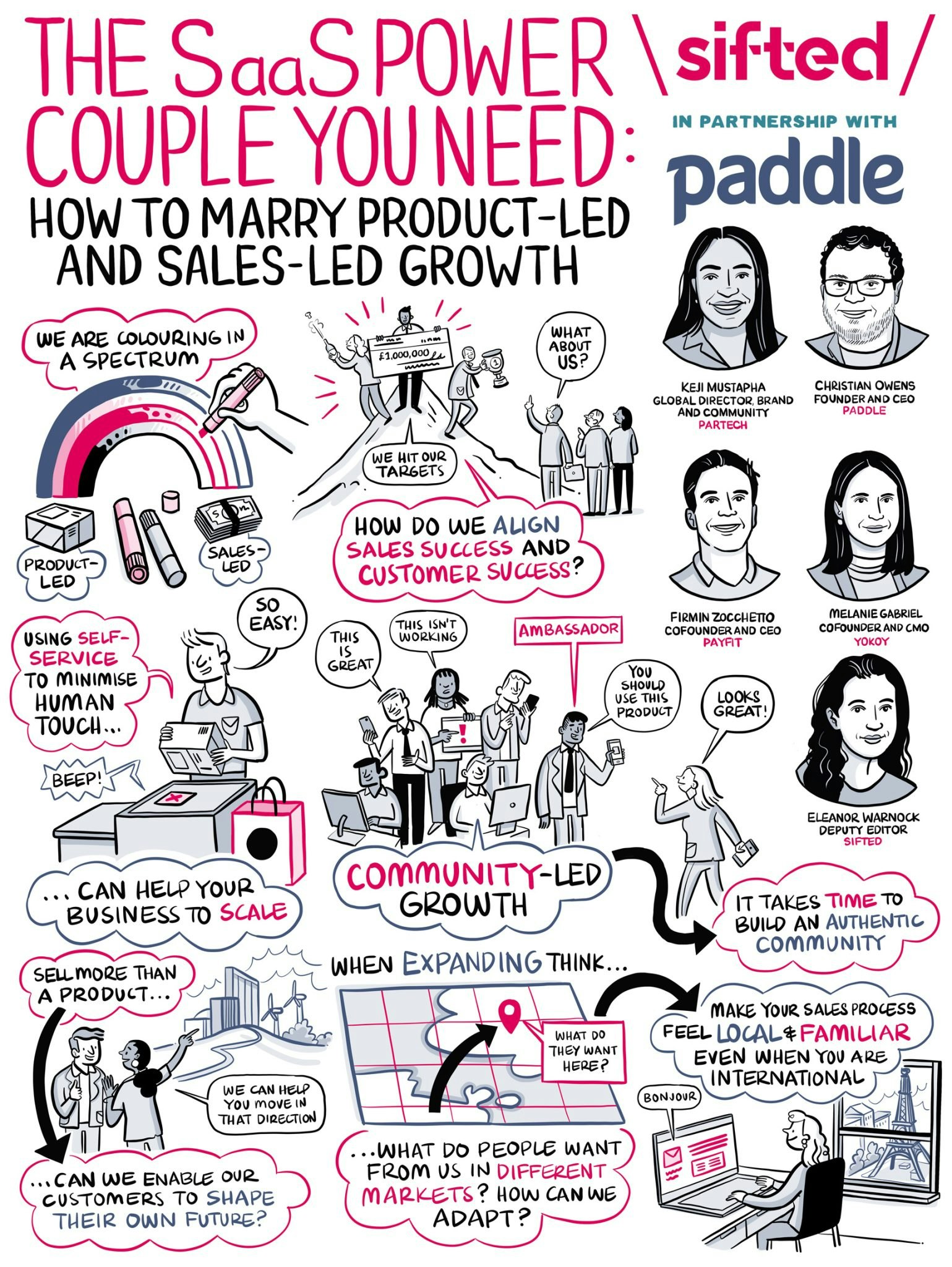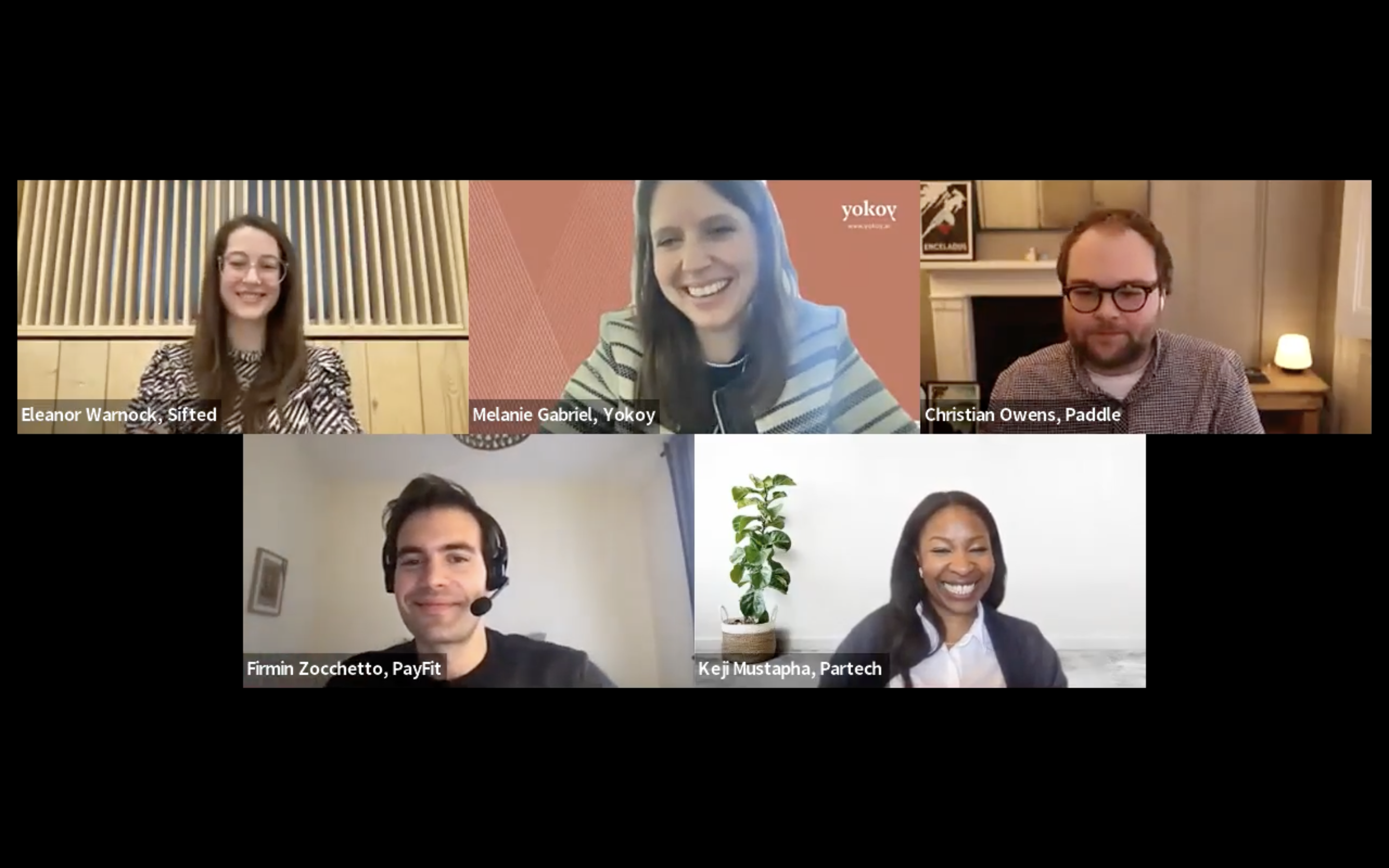In 2021, the global market for SaaS had an estimated worth of $145.5bn — and it’s set to grow even more in 2022, meaning competition for market share is red hot.
But what’s the best way to get more users? Some SaaS companies let the product sell themselves, some invest big in sales teams and others rely on existing customers to get new ones.
In our recent Sifted Talks, we asked our expert panel for their best tips on how startups can use both product-led and sales-led growth to succeed. Our panellists were:
- Christian Owens, founder and CEO, Paddle, a revenue delivery platform
- Melanie Gabriel, cofounder and CMO, Yokoy, a Switzerland based spending management platform
- Keji Mustapha, global director brand and community, Partech, an investment platform for tech and digital companies
- Firmin Zocchetto, cofounder and CEO, PayFit, a payroll management system

1/ Take your time to build a community
Communities can be a great way to engage users around their product, get feedback and add value to the user experience. But Mustapha said that some companies don’t take a long-term approach to community building — they just build a Slack space and expect users to engage.
She added that startups need to think carefully about how they are going to connect people and what tools they are going to use to do this, like which platform to use.
It takes time to build an authentic community where people get meaningful connections and engagement. It can't be manufactured. I think one of the challenges is not understanding the time it takes and not doing the initial work before starting” — Keji Mustapha, Partech
It's the great war for talent — how will you compete? Our next Sifted Talks on February 16 is all about how CFOs and founders can protect their workforce from being poached. Sign up here.
2/ Smaller companies should concentrate on product
It’s a chicken-and-egg situation: when should startups concentrate on sales vs. product?
Gabriel said sales teams can sometimes get too fixated on selling rather than thinking about what the customer actually needs, which can lead to problems later down the line.
Zocchetto told us that he sold to his first 200 customers without a demo, but needed to always make himself available if these customers needed him for any issues and take on user feedback.
You as a solo founder should put all of your energy during the day on building the product and every spare minute that you have speaking to potential customers. In the early stages, that’s not to sell to them — it's to get feedback and understand the problem” — Christian Owens, Paddle
3/ Knowledge share
As well as learning from their customers, Gabriel said that different teams within a business should collaborate and learn from each other.
While this isn't exclusive for SaaS companies, Yokoy runs interactive training weeks where different departments get together and share their insights.
She added that it helps align the teams and reinforce shared goals. She said it’s important to follow up on these sessions and to show what everyone has achieved from them.
The whole organisation has so much knowledge about what works and in which countries and which target groups we have there. It is a pity if sales teams only know how to sell stuff. We have regular weeks where we have different teams working and brainstorming with each other” — Melanie Gabriel, Yokoy
4/ Know your customer
The panel discussed how some customers may need a product-led approach and some may respond better to a sales-led approach.
Owens said sales teams need to work out where their skills are best utilised. He added that they need to sell to customers who will engage in conversation, and that it’s pointless to use brute force to try to sell to someone who doesn’t want to be sold to.
Zocchetto said that both approaches can complement each other and founders should think about diversifying their techniques to acquire customers. Some customers may be happy to buy without consulting the sales team but may require human input when it comes to learning how to use the product or troubleshooting.
You can do both, you don't have to choose. There are customers that are digital natives that will want to use your solution without talking to anyone at your company… There are others that need to talk to humans, sometimes you will even have to go and meet them in person” — Firmin Zocchetto, PayFit

5/ Break down barriers
Owens said that regardless of where a customer is buying a product, it should feel like they’re buying it locally. Founders need to use local currency, local domain names and have contracts in a customer’s native language. This will reassure the customer and provide a better experience.
When it doesn't feel familiar, when it doesn't feel local, each one of those things diminishes your confidence in either the product or the process overall” — Owens, Paddle
6/ Brush up on your sales tactics
The panel finished by sharing their top sales tips. Owens said you needed to know and love the product — when you can empathise with it, you can sell it better.
Gabriel stressed how important it is to think of B2B customers as human beings and not just customers. They all have different needs and problems.
Brush up on your listening skills because most of sales is listening to hear what is being said, and not what is being said, and reading between the lines. Become a good storyteller. Ultimately as a sales person you are telling a story that is hooking the end user and making them think that's me” — Mustapha, Partech
For more on marrying product and sales, watch the full Sifted Talks here:

